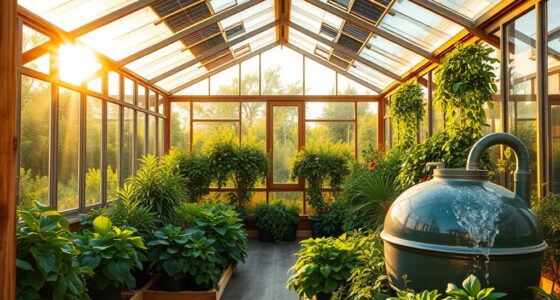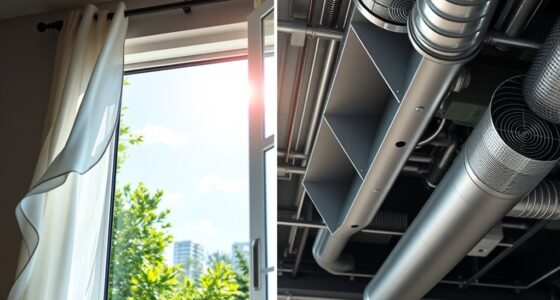Implementing carbon‑capture units in your greenhouse can substantially boost crop yields by recycling CO2 to enhance photosynthesis, leading to healthier, faster-growing plants. These systems also cut emissions, making your operation more eco-friendly and compliant with environmental standards. By integrating renewable energy and precise control, you can lower energy costs and reduce your carbon footprint. Keep exploring to discover how this innovative technology can transform your greenhouse for greater efficiency and sustainability.
Key Takeaways
- Carbon-capture units recycle CO2 to boost plant growth and increase crop yields.
- They reduce greenhouse gas emissions, helping greenhouses meet environmental standards.
- Integration with renewable energy sources minimizes energy use and operational costs.
- Precise CO2 control improves photosynthesis, crop quality, and overall productivity.
- Implementing these units enhances sustainability, attracts eco-conscious consumers, and future-proofs operations.

Greenhouses are increasingly adopting carbon-capture units to reduce their environmental impact and improve sustainability. By integrating these systems, you’re taking a proactive step toward utilizing sustainable energy sources and creating a more eco-friendly operation. Carbon capture isn’t just about reducing emissions; it also serves as a catalyst for crop enhancement. When you capture and recycle carbon dioxide, you provide your plants with a crucial nutrient that promotes faster growth and higher yields, making your greenhouse more productive and efficient.
Implementing carbon-capture units allows you to maximize the internal environment of your greenhouse. Instead of relying solely on external sources for CO2, you can recirculate captured carbon dioxide back into your growing space. This process enhances photosynthesis, which directly translates to more vigorous plants and improved crop quality. The result is not only a greener operation but also an increase in your overall yield. The synergy between sustainable energy and crop enhancement becomes evident here—by capturing carbon, you’re reducing reliance on energy-intensive methods and simultaneously boosting your plants’ growth potential.
Moreover, these units contribute to energy efficiency. Since they can be integrated with renewable energy systems, such as solar or wind, your greenhouse can operate with a smaller carbon footprint. This integration ensures that your energy consumption aligns with sustainable practices, helping you meet environmental standards and possibly reducing operational costs in the long run. As a result, you’re not just improving your crop output but also reinforcing your commitment to sustainability, which appeals to environmentally conscious consumers and stakeholders.
Using carbon-capture technology also opens opportunities for innovation within your greenhouse operations. You can monitor and adjust CO2 levels dynamically, ensuring your plants always receive ideal conditions for growth. This precise control minimizes waste and maximizes resource use, making your entire system more resilient and sustainable. Additionally, understanding the cost and budgeting aspects of implementing these systems can help plan for long-term investment and operational efficiency. As you adopt these units, you position yourself at the forefront of agricultural technology, demonstrating leadership in sustainable practices.
Frequently Asked Questions
What Are the Initial Costs of Installing Carbon-Capture Units?
When considering installing carbon-capture units, you should do a thorough cost analysis to understand the initial investment. Costs can vary based on the size and technology of the system, but expect to pay for equipment and installation. Luckily, many regions offer financial incentives that can help offset these costs. Factoring in these incentives can make the investment more affordable, ensuring you maximize benefits while reducing emissions and increasing yield.
How Much Space Do These Units Require in a Greenhouse?
Imagine optimizing your greenhouse’s potential without feeling overwhelmed. The space requirements for these units are quite manageable, with compact unit dimensions designed to fit seamlessly into your setup. Typically, they occupy a modest footprint, allowing you to maintain efficient airflow and access. This means you can integrate carbon-capture technology smoothly, enhancing your greenhouse’s productivity without sacrificing valuable space. It’s a smart step toward greener, more productive growing.
Are Carbon-Capture Units Suitable for All Types of Crops?
You might wonder if carbon-capture units suit all crop types. While they can benefit diverse crops by improving air quality and boosting yields, their effectiveness varies. For crop diversity, these units help maintain ideal conditions, but they’re less effective if pest control issues persist. Always assess your specific crop needs and environmental factors to determine if a carbon‑capture system aligns with your greenhouse’s unique requirements.
What Maintenance Is Needed for the Units Over Time?
You might find it interesting that maintaining these units is simpler than you think. Over time, you’ll need to check the filters regularly and replace them when they get clogged. System calibration is essential to keep everything running smoothly and efficiently. By staying on top of filter replacement and calibration, you’ll ensure your units operate at their best, helping you maximize yields and minimize emissions without much hassle.
Can These Units Be Integrated With Existing Greenhouse Systems?
You can integrate these units with your existing greenhouse systems, but be aware of potential integration challenges. The units are designed for retrofit compatibility, making installation smoother, yet some systems may require adjustments. Confirm you consult with the manufacturer or a specialist to address compatibility issues and streamline the process. Proper planning helps avoid delays and guarantees your greenhouse benefits from enhanced yield and emissions reduction efficiently.
Conclusion
By installing carbon-capture units, you can double your greenhouse yield while reducing emissions by up to 50%. Imagine increasing your crop output without harming the environment—that’s the power of this innovative technology. With greenhouse gases being a major contributor to climate change, adopting these units not only boosts your productivity but also helps combat global warming. Embrace this change and see your greenhouse thrive while making a positive impact on the planet.










